Rotterdam is the second largest city in the Netherlands, home to the most important port in Europe and the fourth busiest port in the world. While 60% of the Netherlands, also known as one of the Low Countries, is found below sea level, Rotterdam has nearly 80% of its territory below sea level, as it lies within the Rhine-Meuse-Scheldt river delta and the North Sea. For that reason Rotterdam is especially prone to flooding. Were it not for its extensive experience and a network of dams, dikes, and dunes, Rotterdam would nearly be constantly underwater.
Aware of its vulnerability to storm surges and floods, Rotterdam today has become an example of the best practices of climate adaptation, given their expertise on the impacts of climate change, and innovative technology and office buildings. As such, Rotterdam is a member of the Cities Climate Leadership Group (C40) and the Connecting Delta Cities (CDC).
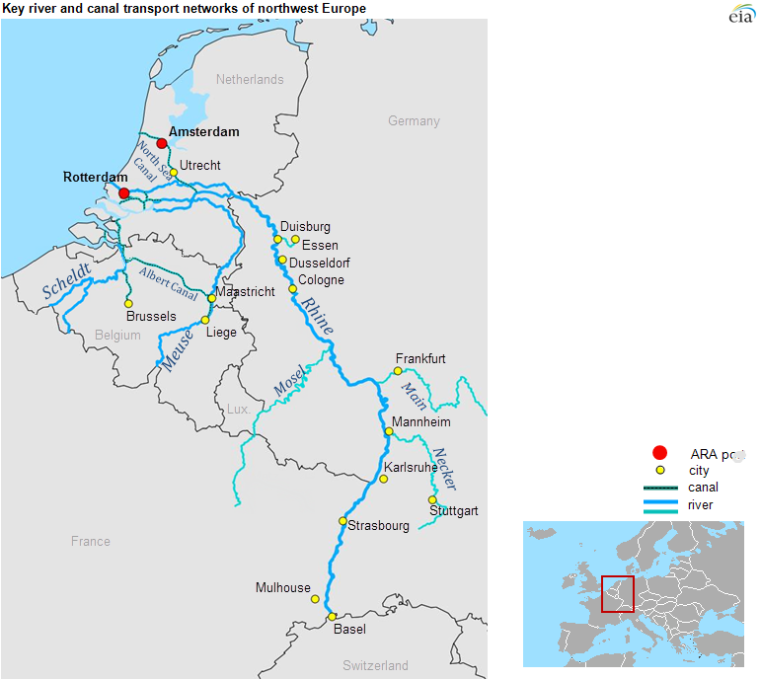
Rotterdam set an example to be followed on climate resilience due to its response to a major disaster that hit the Netherlands, Belgium, England and Scotland in 1953. The 1953 North Sea Flood caused the biggest damage in the Netherlands, where water took over 200,000 ha (800,000 acres) and the lives of more than 1,800 people and 200,000 cattle, causing widespread property destruction, damaging dikes and dams, contaminating potable water sources and bringing salt water to what used to be fertile soil, hurting Rotterdam’s agricultural yield for many years.
The 1953 North Sea Flood was the worst natural disaster that Northern Europe had seen in more than two centuries. As the water level rose 3.8 meters (12.5 feet) above mean sea level, combined with a high spring tide, almost a third of the Dutch coastal areas flooded in less than 24 hours, leaving more than 72,000 people in and around Rotterdam homeless overnight.
 Extent of flooding in the Netherlands
Extent of flooding in the Netherlands  Flood marks in the delta area. Source: Royal Society Publishing
Flood marks in the delta area. Source: Royal Society Publishing
However unexpected the severity of the North Sea storm was, extensive damage and a less than speedy recovery were both caused by a combination of a few aspects. Most of these issues are still quite common all over the world and are representative of the city/country ability to manage a natural disaster:
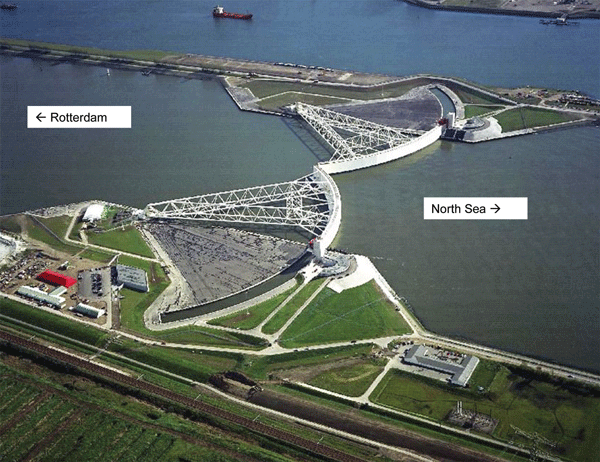 The Maeslantkering protect the port of Rotterdam against North Sea storm surges. The gates are shown closed in the storm surge position. Normally, the gates are kept open, rotated back into their parking areas.
The Maeslantkering protect the port of Rotterdam against North Sea storm surges. The gates are shown closed in the storm surge position. Normally, the gates are kept open, rotated back into their parking areas.
 Rowing boats were used in the rescue because they could be better maneuvered around fences, hedges and through the floating debris in the shallow waters. Source: The Royal Society
Rowing boats were used in the rescue because they could be better maneuvered around fences, hedges and through the floating debris in the shallow waters. Source: The Royal Society
emergency offices in the most affected areas were understaffed. The U.S. Air Force were the first respondents to come to the rescue of American and British families, sending servicemen over from Germany. However, many of the rescues were done by civilians. For the most part, there were no rescue plans or rescue teams, other than what could be formed at the spur of the moment. Most of the organized government assistance only began on Monday, February 2nd.
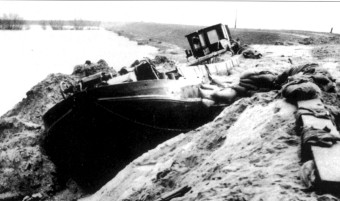 Ship closes dike breach and saved the central parts of Holland from flooding (from Slager 1992; photo: C. van Gennip).
Ship closes dike breach and saved the central parts of Holland from flooding (from Slager 1992; photo: C. van Gennip). 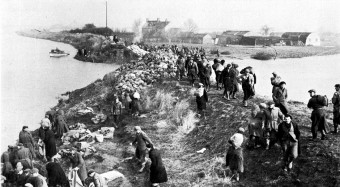 Civilians work to repair broken dam
Civilians work to repair broken dam  Breach at Ouderkerk aan de IJssel, upstream along the tidal reach of the river Hollandse IJssel, at the time of tidal low water (from Van Veen 1962).
Breach at Ouderkerk aan de IJssel, upstream along the tidal reach of the river Hollandse IJssel, at the time of tidal low water (from Van Veen 1962). 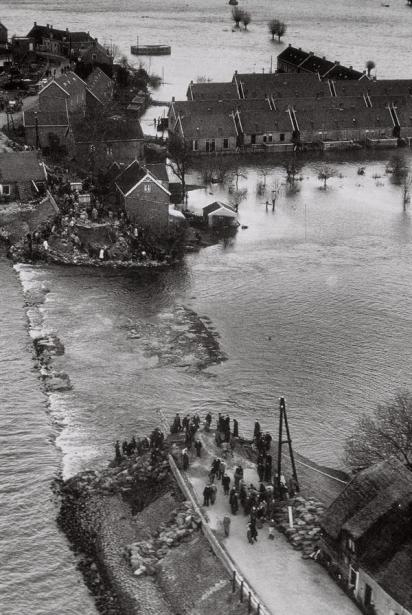 Breach on dike from storm surge
Breach on dike from storm surge 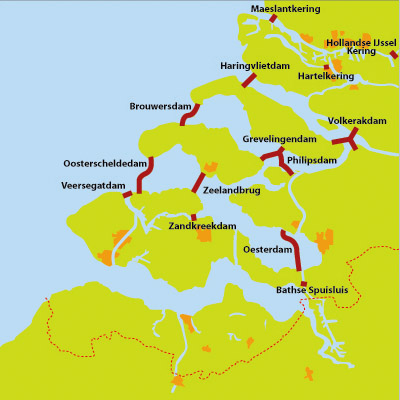 Location of each one of the 13 built storm management infrastructures from Delta Works
Location of each one of the 13 built storm management infrastructures from Delta Works
Less than a month after the flood, the first Delta Committee was formed to advise the government on measures to prevent similar disasters in the future. From this committee came the plan known as the Delta Works Project, designed to protect the estuaries of the rivers Rhine, Meuse, and Scheldt. The plan consisted of a series of 13 dams and storm surge barriers that not only served as protection, but also improved the agricultural freshwater supply and helped increase mobility and traffic between previously isolated islands and peninsulas.
Since its inception, The Delta Works project has evolved. Initially, the plan called for estuaries to be dammed and turned into lakes, but as environmental concerns rose, it was decided that barriers would be erected to protect from storm surges instead. The Delta Works project was officially completed in 1997 at the total cost of $7 billion. However, the Netherlands continues to add infrastructure as needed. This is because, although the Dutch are accustomed to living below sea level and have become no strangers to dikes and barriers, they still experience unprecedented amounts of unpredictable rainfalls, along with longer periods of drought and extensive heat waves today.
 Oosterschelde storm-surge-barrier in the Netherlands. The biggest and boldest project from Delta Works
Oosterschelde storm-surge-barrier in the Netherlands. The biggest and boldest project from Delta Works  The Maeslantkering protect the port of Rotterdam against North Sea storm surges. The gates are shown closed in the storm surge position. Normally, the gates are kept open, rotated back into their parking areas.
The Maeslantkering protect the port of Rotterdam against North Sea storm surges. The gates are shown closed in the storm surge position. Normally, the gates are kept open, rotated back into their parking areas. 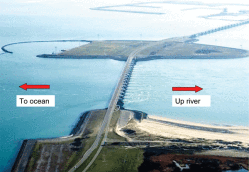 Segment of the Zuiderzee Works. The system is composed of a mixture of elevated natural sand dunes, tidal gates (normally open), elevated highways and shipping gates. The photo was taken during flooding (incoming) tides. During storm surges, gates are lowered from the highway for protection. Source: Downtown Express.com
Segment of the Zuiderzee Works. The system is composed of a mixture of elevated natural sand dunes, tidal gates (normally open), elevated highways and shipping gates. The photo was taken during flooding (incoming) tides. During storm surges, gates are lowered from the highway for protection. Source: Downtown Express.com  Hollandse IJssel Barrier, in Rotterdam
Hollandse IJssel Barrier, in Rotterdam
Storm surge barriers consist of a series of massive valves that are usually kept open so that water can circulate in and out of the estuary, helping preserve the natural environment. However the valves can be closed to create a dam during a storm to protect the main land from potential flooding.
While undoubtedly disastrous, the storm flood of 1953 lead to the creation of the Delta Works Project, which ultimately led to crucial advances in hydraulic engineering and dredging technology. These advancements have proven pivotal, making Rotterdam one of the safest delta cities in the world, despite experiencing the direct problems that climate change has brought.
Other Aspects of Rotterdam’s Climate Resilience StrategyAlthough the Delta Works Project marks the of Rotterdam’s climate change resilience strategy, the beauty of the strategy is that it doesn’t rely exclusively on the city’s robust system of storm surge barriers, dikes, canals, lakes, outlets, sewers, and pumping stations. While those initiatives are essential, adaptation must also come from other aspects of the urban environment such as green roofs and water squares.
The Rotterdam Climate Proof program, ratified in 2008, intends to make the city 100% resilient to climate change by 2025, with hopes to turn every conceivable area into water storage. From building water storage facilities at underground parking garages to creating floating neighborhoods with homes, offices, schools, parks and factories. Every conceivable space is considered for water retention to delay rainwater from entering and overflowing the waste stream, therefore preventing floods.
In 2016, the city Rotterdam released the Climate Change Adaptation Strategy, and also makes it available here. One of the most interesting things about Rotterdam’s strategy is that the Rotterdam Climate Change Adaptation Strategy and the Rotterdam Climate Initiative are two complementary measures, in a way to tackle both, the causes and consequences of climate change. The first provides a framework for all parties working in and for the city on efforts that will lead Rotterdam to a climate-proof city. The second focuses on prevention of climate change. Its pivotal objective is to reduce carbon dioxide emissions by 50% and make the whole city 100% climate proof by 2025. With this goal in mind some of the climate change mitigation initiatives involve the City of Rotterdam increasing their investments in sustainability and accelerating solar energy generation by installing solar panels on the roofs of municipal gyms and schools.
As Rotterdam aims at keeping the city safe, accessible and attractive to people and businesses, it is making clear investments in climate solutions, hoping to become a leading center for water knowledge and climate change expertise that is economically prosperous. With such bold goals, all mitigation and resilience strategies have to be aligned as a means to complement each other and involve society and multiple companies and organizations.
Advertisements Share this:




